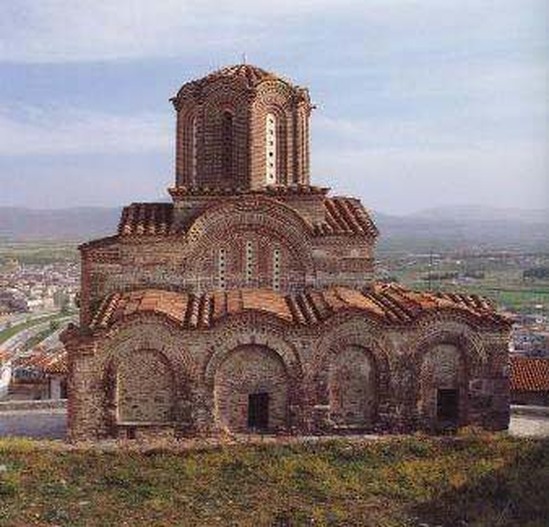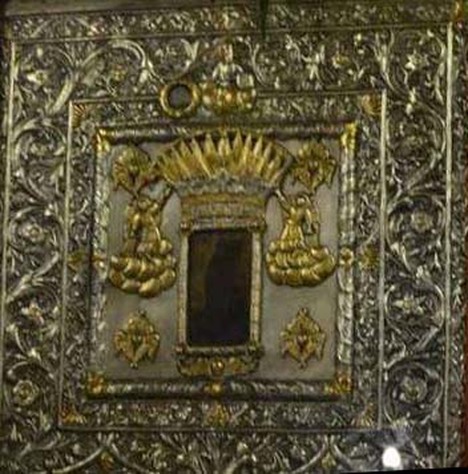Monastery of Panageia (Theotokos) Olympiotissa

We enter Elassona passing a military base (everyone is prohibited from taking photos of military instillations in Greece.. The rock formations resemble icon rocks and we see the monastery perched atop one of the hills. Snaking up S-curve turns Vasili honks at each curve in the road. I remember this from 1966, “I’m here, stay in your lane” Good that the Great Mother is here to protect us from Zeus. We arrived at the gates of this 13th c. monastery, unusual in shape for its time but similar to the both the Church of St. Ekaterina (Catherine) in Thessaloniki and to Serbian architecture.
A book in Greek published in 2007 at the monastery indicates that an early monk’s Code says that the monastic community itself was founded in the 5th century. The building itself, from 1296, sits on the highest hill, Olympiotissa, near Mt. Olympus. Until the fall of the Byzantine Empire it was known as the Monastery of the Transfiguration of Christ.
A wonderful sister at the convent told us the story of the Miracle Icon from which the monastery gets its name. Here is the legend of the famous icon that now sits in the narthex. It was originally from a church near the village of Katrina and was know widely before 1453 for its miracles. One night a shepherd awoke from a bright light in some bushes where he was sleeping, grew frightened and threw a stone toward where he saw the light. Immediately his arm became paralyzed, and when he retold the story to his villagers and curious about his story they set out to find its source. They found the icon and realizing its significance took it to the Transfiguration Monastery. Since it depicted the Panageia (Theotokos/Virgin), the monks change its name to The Monastery of the Panageia of Olympiotissa.
The 13th c. frescoes inside the church are some of the most remarkably preserved of the fresco cycles of this late Byzantine period. Though there are hammer marks from Turkish defacement, particularly the eyes of the saints, several of the most intact images are those of St. Ephraim the Syrian, St Theodore Stratelates, St. Theodore Tyron, St. John the Baptist and St. Nicholas. Other frescoes depict the Five Martyrs of Persia, the Three Youths in the Fiery Furnace, and images from the Akathist Hymn to the Theotokos.
The intricately wooden carved iconostasis is from the 19th c. and depicts various biblical stories. During World Ware II the western wall damaged by an earthquake. Bombs dropping over the domes unexplainably fell away from the church onto the surrounding hills, and local belief is that the church was saved by her protectress, the Panageia. In 1997 the monastery for men became a women’s community. According to our host for centuries the village of Elassona supported the monastery. Now the monastery provides jobs and benefits the community.
A book in Greek published in 2007 at the monastery indicates that an early monk’s Code says that the monastic community itself was founded in the 5th century. The building itself, from 1296, sits on the highest hill, Olympiotissa, near Mt. Olympus. Until the fall of the Byzantine Empire it was known as the Monastery of the Transfiguration of Christ.
A wonderful sister at the convent told us the story of the Miracle Icon from which the monastery gets its name. Here is the legend of the famous icon that now sits in the narthex. It was originally from a church near the village of Katrina and was know widely before 1453 for its miracles. One night a shepherd awoke from a bright light in some bushes where he was sleeping, grew frightened and threw a stone toward where he saw the light. Immediately his arm became paralyzed, and when he retold the story to his villagers and curious about his story they set out to find its source. They found the icon and realizing its significance took it to the Transfiguration Monastery. Since it depicted the Panageia (Theotokos/Virgin), the monks change its name to The Monastery of the Panageia of Olympiotissa.
The 13th c. frescoes inside the church are some of the most remarkably preserved of the fresco cycles of this late Byzantine period. Though there are hammer marks from Turkish defacement, particularly the eyes of the saints, several of the most intact images are those of St. Ephraim the Syrian, St Theodore Stratelates, St. Theodore Tyron, St. John the Baptist and St. Nicholas. Other frescoes depict the Five Martyrs of Persia, the Three Youths in the Fiery Furnace, and images from the Akathist Hymn to the Theotokos.
The intricately wooden carved iconostasis is from the 19th c. and depicts various biblical stories. During World Ware II the western wall damaged by an earthquake. Bombs dropping over the domes unexplainably fell away from the church onto the surrounding hills, and local belief is that the church was saved by her protectress, the Panageia. In 1997 the monastery for men became a women’s community. According to our host for centuries the village of Elassona supported the monastery. Now the monastery provides jobs and benefits the community.

The rock in the icon is still embedded in the frame;. The icon is know to have produced many miracles. The monastery was a men's community until 1997 when it became a convent. Originally the 12th c. monastery was named for the Feast of the Transfiguration of Christ. The Riza of this icon is elaborately tooled i silver. The icon image itself is quite small, with decorative, almost folk, figures holding up the gold crown of the Panageia. On the top left is the round reliquary housing the shepherd's rock.
The intricately carved wooden iconostasis is from the 18th c.
Slides below are frescoes from the church.